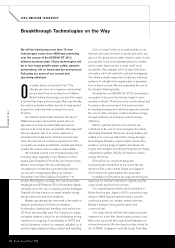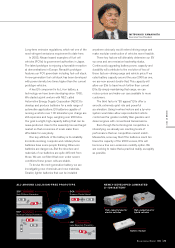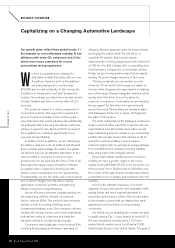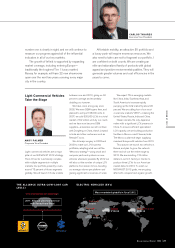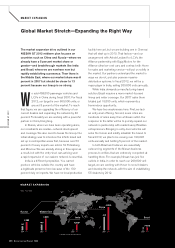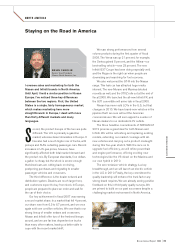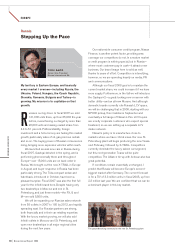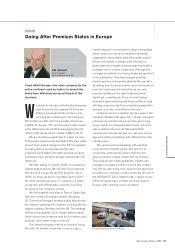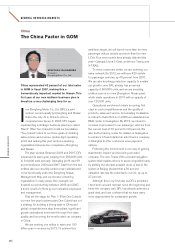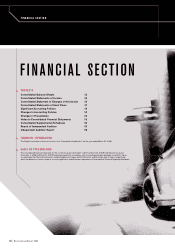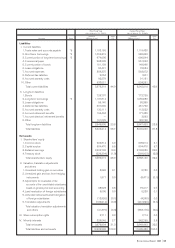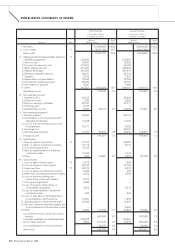Nissan 2008 Annual Report Download - page 36
Download and view the complete annual report
Please find page 36 of the 2008 Nissan annual report below. You can navigate through the pages in the report by either clicking on the pages listed below, or by using the keyword search tool below to find specific information within the annual report.
34 Nissan Annual Report 2008
REGIONAL HIGHLIGHTS
JAPAN
Stimulating the Market
to Create a Positive Growth Cycle
Japan’s auto market is facing an unprecedented
drought. Starting in fiscal 2006, total demand
fell by nearly 540,000 units.
Beyond the demographic and market
changes—including an aging populace, low
birthrate, and the growing diversification in
consumer tastes—the surge in gasoline prices
has decreased demand. The shift to mini-vehicles
has also accelerated the decrease, resulting in sales
of just 3.43 million registered vehicles during fiscal
2007—the lowest level since 1974. Every automaker
is launching more new models in an attempt to
reenergize the market, which has led to more
relentless competition.
As the market grows increasingly harsh,
maintaining sales and production and boosting
profitability are essential to keeping Japan globally
competitive. Now is the time to introduce innovative
changes that will revitalize the market and shift
business into a positive growth cycle. The Japan
Performance Revival Plan, a project we launched in
fiscal 2007, one year before NISSAN GT 2012, is
our engine for accomplishing that goal. The plan’s
four pillars promote makeovers in every area,
including manufacturing, sales, and administration.
The first pillar is to bring more attractive products
and technologies to market. We are reacting to the
radical shifts in consumer values by accelerating our
efforts to provide innovative vehicles that excite
drivers. We believe our market presence is growing
stronger as a result. Sales of new models in fiscal
2007 exceeded our estimates, and vehicles updated
with minor changes such as the Serena have been
selling steadily. During the next five years, Nissan
plans to launch 60 new models globally—33 of them
in Japan—and we will continue to anticipate
changing market needs and offer striking cars with
exceptional performance.
The second pillar is to refine our marketing skills.
As announced in March 2007, the objective of our
network strategy is to bolster dealer operations,
focusing on the quality of our sales interactions,
including higher productivity and more effective
customer-handling skills. Our fully incorporated
regional companies began these reforms in the
Tokai area in 2007, followed by the greater Tokyo
metropolitan and Kinki regions in June 2008. They
are sharing operational know-how and best practices
of top-performing outlets.
Cost structure reform is the third pillar of our
plan. We have been revamping our sales network
and production system since the Nissan Revival Plan
years. As the Japanese market shrinks and
production becomes both more globalized and
localized, domestic sales and production volumes
have dropped drastically.
To reinforce our operational base here, we must
seize every opportunity for cost efficiency and
optimization. One recent initiative is the “in-plant
challenge,” which promotes low-cost automation,
further integrating onsite manufacturing ability and
the technical skills of our engineers. Starting at the
Oppama plant, we are introducing this at all our
factories here. Our aim is to have the best, most
cost-competitive plants in the world.
The last pillar is to expand our value-chain
business. Nissan’s share of new vehicle sales in
Japan was 13.6 percent in fiscal 2007. In the
broadest sense, we supplied around half of all new
vehicles. This includes expanding segments—such
as the rental car business—where we can become
more prominent. During a period in which we expect
less demand for new vehicles from consumers,
enlarging the value chain will supplement sales and
stabilize our earnings.
That, in turn, will build Nissan’s business base
and spur a rise in our investments in human
resources and outlets, benefiting the greater value
chain that exists outside our company. In this way,
Nissan will help energize and activate a positive
growth cycle in Japan’s marketplace.
TOSHIYUKI SHIGA
Chief Operating Officer


